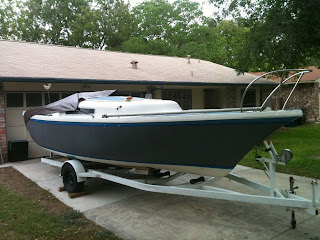Yet another couple of weeks transpired before I could return to repairing the Clipper. The weather had changed for the best, bringing in cooler temperatures along with the occasional torrential downpour. Knowing of the eventual storms to come, I decided it was most likely a good idea to purchase a heavy duty tarp to cover over the cockpit.
With the tilt of the boat leading toward the bow due to the slant of the driveway, the self-balers would not have as much opportunity to perform their duties of successfully draining the cockpit. I figured the tarp should help with keeping as much water out as possible.
While waiting to see what our next step might be in raising the boat off the trailer, I decided it was as good a time as any to fine sand the hull and apply some primer.
I acquired some Interlux Pre-Kote primer in grey. I juggled the idea back and forth of using the white primer instead of the grey, but I surmised that this darker share of primer might help in spotting any areas of the hull that might require more sanding and fairing.
Anthony proved to be quite the handyman when it came to taping and masking off the boot stripes along the hull. Even the curved areas along the bottom aft where the stripe became larger seemed to pose no real challenge.
I guess he had done this quite a few times before.
Once all of the masking was completed, I once again washed down the hull with soapy water, then rinsed with the pressure washer, and then wiped down the surface with a lint free cloth and a light solvent mix.
The surface was very smooth and ready to be primed.
The 6" foam rollers I had picked up for the job of priming worked remarkably well with the Pre-Kote product. Little pressure was needed to spread the primer. I was also quite surprised how far the primer went. I was able to successfully paint a single coat over the entire port side of the hull with only half a quart.
The only issues I seemed to encounter were around the leading edge of the hull under the bow.
Because of existing trailer hardware that I could not remove from my path, I simply used a brush to tip off the edges. Once I painted as many corners as I could access, I finished up the starboard side of the hull with the second half of the quart.
This was starting to look like a totally different boat from what I had original sailed.
Once again, I tipped of the edges of the starboard side and completed the single coat up to the leading edge of the hull.
It was now time to perform some trailer rewiring.
Anthony had previously removed the "original" trailer wiring that had been routed externally and zipped tied around the steel tubing along the length of the trailer. I picked up a 50' spool of four color trailer wiring to make the wire run internally; what should have originally been done when the trailer was wired.
We started be drilling out the rear left side of the steel tubing with a metal cutting bit, and grinding it out to smooth it for the wires.
It was no easy task to drill through a 1/4" thick steel plate from the angle we had, but after some persistent pressure between me and Anthony, the steel finally gave way.
After removing the hitch coupler from the front of the trailer, we found inside the tubing was an old bundle of trailer wiring that had been run down both sides of the trailer. It appeared that someone actually extended the length of the trailer to accommodate the Clipper, but left a run of burned and rusted wiring. Why they did not choose to pull it all out and replace it instead of wiring from the outside is beyond me.
After pulling out the old bundle, I then ran a cable snake down the left side of the trailer, towards the hole we had drilled out.
Anthony then tied off and taped the new wire to the snake for me to fish back through the steel tubing.
From here, Anthony was able to use a set of water-proof couplers and some epoxy heat-shrink tubing to seal off the connections for the adapters and tail lights.
After a bit of fussing with the connections and testing the run between the left and right tail lights, it appeared we were now in business.
With some new trailer wiring and a good set of water-proof connections, we were now ready to get this boat transported over to a place where we could sand and paint the bottom.














thank god for wiresnakes... coat hangers just don't cut it most of the time! looking good brother!
ReplyDelete